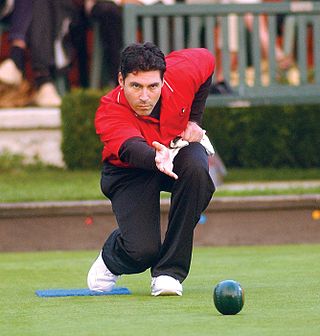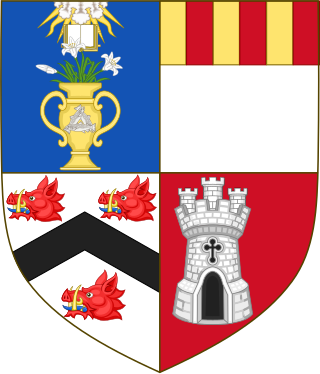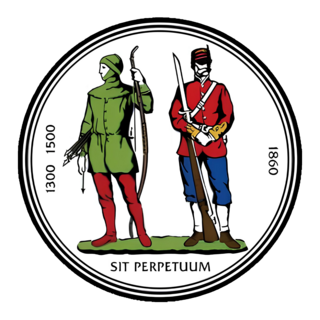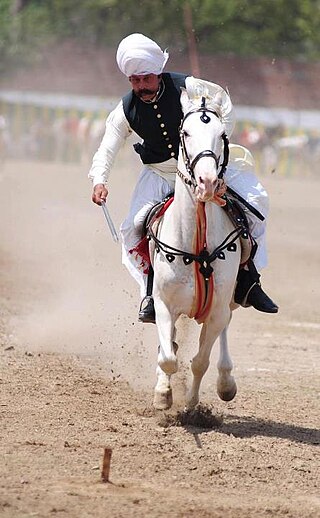Related Research Articles

Aberdeen is a city in North East Scotland, and is the third most populous Scottish city. Historically, Aberdeen was within the historic county of Aberdeenshire, but is now separate from the council area of Aberdeenshire.

Bowls, also known as lawn bowls or lawn bowling, is a sport in which players try to roll their ball closest to a smaller ball. The bowls are shaped (biased), so that they follow a curved path when being rolled. The game is played either in teams or one against one.

Hogmanay is the Scots word for the last day of the old year and is synonymous with the celebration of the New Year in the Scottish manner. It is normally followed by further celebration on the morning of New Year's Day and, in some cases, 2 January—a Scottish bank holiday. In a few contexts, the word Hogmanay is used more loosely to describe the entire period consisting of the last few days of the old year and the first few days of the new year. For instance, not all events held under the banner of Edinburgh's Hogmanay take place on 31 December.

Shooting sports is a group of competitive and recreational sporting activities involving proficiency tests of accuracy, precision and speed in shooting — the art of using ranged weapons, mainly small arms and bows/crossbows.

Shinty is a team sport played with sticks and a ball. Shinty is now played mainly in the Scottish Highlands and among Highland migrants to the major cities of Scotland, but it was formerly more widespread in Scotland, and was even played in Northern England into the second half of the 20th century and other areas in the world where Scottish Highlanders migrated.

Ernest Thompson Seton was a Canadian and American author, wildlife artist, founder of the Woodcraft Indians in 1902, and one of the founding pioneers of the Boy Scouts of America (BSA) in 1910.

The M1 Garand or M1 rifle is a semi-automatic rifle that was the service rifle of the U.S. Army during World War II and the Korean War.

The University of Aberdeen is a public research university in Aberdeen, Scotland. It was founded in 1495 when William Elphinstone, Bishop of Aberdeen and Chancellor of Scotland, petitioned Pope Alexander VI on behalf of James IV, King of Scots to establish King's College, making it one of Scotland's four ancient universities and the fifth-oldest university in the English-speaking world. Along with the universities of St Andrews, Glasgow, and Edinburgh, the university was part of the Scottish Enlightenment during the 18th century.

Camping is a form of outdoor recreation or outdoor education involving overnight stays with a basic temporary shelter such as a tent. Camping can also include a recreational vehicle, sheltered cabins, a permanent tent, a shelter such as a bivy or tarp, or no shelter at all. Typically, participants leave developed areas to spend time outdoors, in pursuit of activities providing them enjoyment or in a form of educational experience. Spending the night away from home distinguishes camping from day-tripping, picnicking, and other outdoor activities.

Aberdeen Football Club is a Scottish professional football club based in Aberdeen, Scotland. They compete in the Scottish Premiership and have never been relegated from the top division of the Scottish football league system since they were elected to the top flight in 1905. Aberdeen have won four Scottish league titles, seven Scottish Cups and six Scottish League Cups. They are also the only Scottish team to have won two European trophies, having won the European Cup Winners' Cup and the European Super Cup in 1983.

Burghead is a small town in Moray, Scotland, about 8 miles (13 km) north-west of Elgin. The town is mainly built on a peninsula that projects north-westward into the Moray Firth, surrounding it by water on three sides. People from Burghead are called Brochers.

Pittodrie Stadium, commonly referred to as Pittodrie, is an all-seater stadium in Aberdeen, Scotland. Used primarily for football, it has been the home ground of the Scottish Professional Football League (SPFL) club Aberdeen F.C. since they were formed in 1903. Prior to then, the ground hosted the original Aberdeen F.C. from 1899 until the merger that created the present club.

The Scottish Football Association Challenge Cup, commonly known as the Scottish Cup, is an annual association football knock-out cup competition for men's football clubs in Scotland. The competition was first held in 1873–74. Entry is open to all 122 clubs with full membership of the Scottish Football Association (SFA), along with up to eight other clubs who are associate members. The competition is called Scottish Gas Men's Scottish Cup for sponsorship reasons.
Eoin Jess is a Scottish football coach and former player.

The National Rifle Association (NRA) is the governing body for full bore rifle and pistol shooting sports in the United Kingdom. The Association was founded in 1859 with the founding aim of raising funds for an annual national rifle meeting to improve standards of marksmanship. Today the NRA continues this objective as well as organising civilian target shooting and selecting British teams to contest the ICFRA World Championships. The National Shooting Centre at Bisley is a wholly owned subsidiary of the association.

Tent pegging is a cavalry sport of ancient origin, and is one of only ten equestrian disciplines officially recognised by the International Equestrian Federation. Used narrowly, the term refers to a specific mounted game with ground targets. More broadly, it refers to the entire class of mounted cavalry games involving pointed and edged weapons on horseback, for which the term "equestrian skill-at-arms" is also used.

This article lists Scottish football attendance records under the categories listed below. The highest ever attendance for a UEFA competition match was in the 1969–70 European Cup semi-final at Hampden Park, Scotland's national stadium. A record 136,505 people attended the match between Celtic and Leeds United. The attendance of 149,415 for the Scotland vs. England international match of 1937 at Hampden Park is also a European record. The attendance of 147,365 for the 1937 Scottish Cup Final between Celtic and Aberdeen at Hampden Park is a European record for a club match. Rangers' record attendance of 118,567 at Ibrox is a British record for a league match.
The Aberdeen University Rifle Club is one of four student rifle clubs competing in the Scottish Student Sport Rifle Competition Circuit. The club currently trains with Robert Gordon's University Rifle Club.

The Scottish Premiership known as the William Hill Premiership for sponsorship reasons, is the top division of the Scottish Professional Football League (SPFL), the league competition for men's professional football clubs in Scotland. The Scottish Premiership was established in July 2013, after the SPFL was formed by a merger of the Scottish Premier League and Scottish Football League. There are 12 teams in this division, with each team playing 38 matches per season. Sixteen clubs have played in the Scottish Premiership since its creation in the 2013–14 season. Celtic are the current league champions, having won the 2023–24 Scottish Premiership.

The Sir Duncan Rice Library is the main academic library for the University of Aberdeen. It was designed by Schmidt Hammer Lassen Architects and completed in 2011. It is named after Duncan Rice, a previous Principal of the university. The cube-shaped building can be seen prominently from the entire campus and much of the city. It is a seven-storey tower, clad in zebra-like jagged stripes of white and clear glass. The building has a floorspace of 15,500 square metres. It houses several of the University's historic collections, including more than a quarter of a million ancient and priceless books and manuscripts that have been collected over five centuries since the University's foundation. There is also public exhibition space. The library replaced the smaller Queen Mother Library as the university's main library.
References
- 1 2 One or more of the preceding sentences incorporates text from a publication now in the public domain : Chisholm, Hugh, ed. (1911). "Wapenshaw". Encyclopædia Britannica . Vol. 28 (11th ed.). Cambridge University Press. p. 304.
- ↑ reference to wapinshaw at barracks in Glasgow
- ↑ notice of wappenshaw competition at Prestwick Howie bowling club
- ↑ report of Wapinshaw competition at Gourock Park bowling club
- ↑ Report on Aberdeen shooting club Wapinshaw, 2011
- ↑ Results of the Aberdeen Wapinshaw, 2013-2016